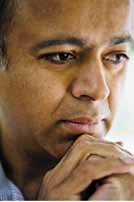Campus News
Arguing for a ‘new humanism’ in medicine
While a new era is dawning for personalized medicine, Abraham Verghese is on a crusade to bring back the lost art of hands-on medical practice.

While a new era is dawning for personalized medicine, Abraham Verghese is on a crusade to bring back the lost art of hands-on medical practice.
“Using the very simple skills of looking at a patient—noticing he is overweight and carrying a pack of cigarettes in his pocket—tells me so much more about his phenotype, and therefore his future, than I can now tell from his genome,” says Verghese, a Stanford University professor of medicine and New York Times bestselling author of Cutting for Stone.
Verghese does not deny the power and utility of the tools of modern medicine. He marvels at how many cancer treatments can now be tailored to a person’s particular tumor type. Verghese does, however, caution physicians against focusing too much on the data generated by today’s tools.
“There is a danger that the patient becomes the ‘iPatient’—a term I coined to represent the virtual construct of the patient in the computer.”
On October 11, Verghese gave a talk entitled “The Art of Medicine in the Era of Homo Technologicus” as part of the Sidhartha Maitra Memorial Lecture series in conjunction with this year’s UCSC Founders Celebration events. He advocated for a new humanism in today’s health care system that, all too often, focuses on a person’s disease rather than on the person.
Verghese suspects we have come to this crossroads as doctors and patients because of health care reimbursement, which is skewed toward procedures and diagnostic tests.
The solution, Verghese says, lies in changing an entrenched system of incentives. “Hospitals make more money in the emergency room when more tests are ordered. Doctors make more money for doing things to patients than they make from listening to the patient, examining the patient, and being thoughtful. If those incentives were reversed, we would solve a lot of problems.”
This article appears in the fall 2011 issue of Review magazine.